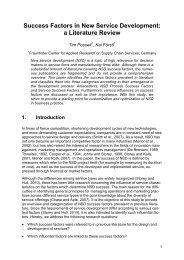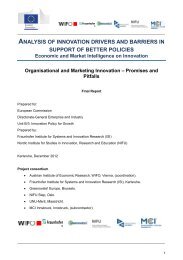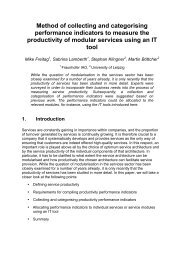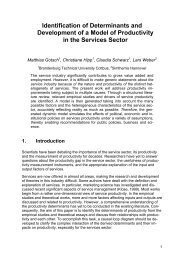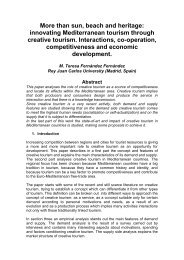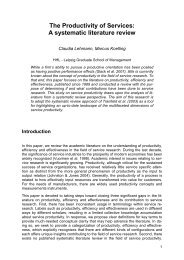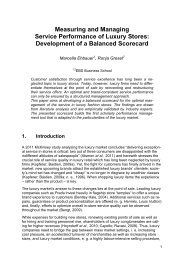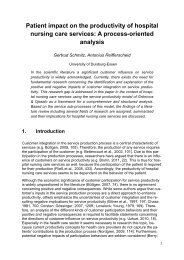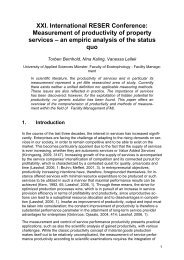A Literature Review and Research Agenda - RESER
A Literature Review and Research Agenda - RESER
A Literature Review and Research Agenda - RESER
Create successful ePaper yourself
Turn your PDF publications into a flip-book with our unique Google optimized e-Paper software.
Service Productivity: A <strong>Literature</strong> <strong>Review</strong> <strong>and</strong><br />
<strong>Research</strong> <strong>Agenda</strong><br />
Bilal Balci 1 , Alicia Hollmann 1 , Christoph Rosenkranz 1<br />
1 Goethe-University Frankfurt, Information Systems Engineering, Dept. of Econonmics<br />
<strong>and</strong> Business Administration<br />
Until now, there exists no universal approach for measuring the productivity<br />
of services. Various factors have different impacts on service productivity,<br />
ranging from the relationship between service providers <strong>and</strong> customers<br />
to service quality. So far, only some of these factors have been investigated<br />
in detail. The purpose of this paper is to describe, synthesize, evaluate,<br />
<strong>and</strong> integrate the results of prior research on service productivity by conducting<br />
a literature review. We selected 13 leading management <strong>and</strong> economic<br />
journals, covering the period of time from 1980 to date. We created<br />
an initial catalogue of existing approaches focusing on the measurement,<br />
validation, <strong>and</strong> controlling of service productivity. We categorize, consolidate,<br />
<strong>and</strong> discuss the relevant papers accordingly. Based on this, we highlight<br />
open issues <strong>and</strong> possible venues for investigation. As our final result,<br />
we develop an agenda for further research on the productivity of services.<br />
1. Introduction<br />
During the last decade, the service sector has been the fastest growing segment <strong>and</strong><br />
represents a major <strong>and</strong> increasing part in the global economy (Russell, 2009). The<br />
significance of services for the prosperity of the world economy has been widely recognized<br />
(Vuorinen et al., 1998; Rai <strong>and</strong> Sambamurthy, 2006). For example, bundles<br />
of physical products <strong>and</strong> services are increasingly offered as an integrated solution to<br />
the customer (Spring <strong>and</strong> Araujo, 2009). Until recently, services have mostly been<br />
understood as value-enhancing “add-ons” for tangible goods. In contrast, the emerging<br />
service-dominant logic regards goods as mere appliances for service delivery<br />
(Lanza <strong>and</strong> Ude, 2010). A service involves at least two partners: a service provider<br />
applying competence <strong>and</strong> a customer that integrates the applied competences with<br />
other resources; therefore value is always co-created (Spohrer et al., 2007).<br />
Smarter service systems serve customers better <strong>and</strong> create more opportunities for<br />
win-win, or benefit-benefit, interactions that result in value co-creation for both service<br />
providers <strong>and</strong> customers (Spohrer <strong>and</strong> Maglio, 2010). This pushes the focus on<br />
service science as an emerging discipline of high relevance to both practice <strong>and</strong> academia<br />
that fosters a cross-disciplinary approach to the study of service systems<br />
(Chesbrough <strong>and</strong> Spohrer, 2006). Underst<strong>and</strong>ing, creating, managing, <strong>and</strong> delivering<br />
successful services calls for systematic studies of managerial, technical, <strong>and</strong> social<br />
issues (Johnston, 1999; Johnston, 2005).<br />
One major issue in the context of service science is how service productivity can be<br />
measured <strong>and</strong> assessed (Grönroos <strong>and</strong> Ojasalo, 2004). The measurement <strong>and</strong> the<br />
improvement of productivity are currently well established in the manufacturing sector<br />
1
(Den Hartigh <strong>and</strong> Zegveld, 2011), where productivity is defined as a ratio of the outputs<br />
of a production unit to its inputs. In contrast, measuring productivity of a service<br />
is not yet as well-developed or well-established. The assessment of service productivity<br />
is not trivial, as services (in contrast to manufacturing) may, to a large extent, be<br />
understood as co-creating configurations of people, technology, as well as internal<br />
<strong>and</strong> external stakeholders connected by value propositions <strong>and</strong> shared information.<br />
As a consequence, no universal definition of service productivity exists (Hilke, 1989;<br />
Maleri <strong>and</strong> Frietzsche, 2008; Reichwald <strong>and</strong> Möslein, 1995).<br />
The present paper reviews the academic literature on the problems <strong>and</strong> issues of<br />
measuring as well as underst<strong>and</strong>ing productivity in the field of services. The purpose<br />
of this literature review is to disclose the current state of research on service productivity,<br />
<strong>and</strong> to develop a research agenda for future research activities in this area. In<br />
order to measure <strong>and</strong> evaluate the findings of our review, we created a catalog of<br />
prevailing approaches already applied in both research <strong>and</strong> practice. Categories that<br />
serve as necessary preconditions for the formation of the concept of service productivity<br />
are further investigated. The aim of this catalog is to show <strong>and</strong> categorize the<br />
current state of research in the field of service productivity. More specifically, the<br />
goals of this study are:<br />
<br />
<br />
<br />
to identify, categorize, <strong>and</strong> critically display the existing approaches used for<br />
measuring <strong>and</strong> evaluating the productivity of services;<br />
to provide an overview of the most important dimensions which influence<br />
service productivity, as well as to estimate their respective importance for the service<br />
productivity;<br />
to form a concept corresponding to the level of knowledge of the present<br />
work for services productivity.<br />
The reminder of this paper is organized as follows. Section 2 introduces related work<br />
that provides the foundation for our analytical framework <strong>and</strong> categories. We then<br />
present the framework of our literature reviews in section 3, describe the literature<br />
review procedure, <strong>and</strong> present our findings in section 4. Finally, we summarize our<br />
findings <strong>and</strong> discuss future research directions.<br />
2. Theoretical Background <strong>and</strong> Related Work<br />
Until recently, the concept of service productivity has been conceptually underdeveloped<br />
(Corsten, 2001). Simply transferring the traditional concept of productivity from<br />
manufacturing <strong>and</strong> producing material goods to services is bound to fail because of<br />
the immateriality <strong>and</strong> intangibility of services (Corsten, 2001). Immateriality refers to<br />
both the intangibility of the output, as well as the heterogeneity of services. Furthermore,<br />
the integration <strong>and</strong> involvement of customers in the value creation processes<br />
is central to services (Lasshof, 2006). This means that the customer is inevitably a<br />
key factor for service providers, which must also somehow be integrated <strong>and</strong> accounted<br />
for in the concept of services productivity. This is in contrast to the classical<br />
concept of productivity, where the customer usually is not an integral part during value<br />
creation <strong>and</strong> the business processes often are a closed system (Grönroos <strong>and</strong><br />
Ojasalo, 2004). This implies that the quality of both material products <strong>and</strong> business<br />
2
processes can neither be perceived nor be influenced by the customer during the<br />
value creation process.<br />
Managing a service is different from managing goods <strong>and</strong> materials (Rust <strong>and</strong><br />
Chung, 2006). This is mostly due to the fundamental nature of a service – a service<br />
is immaterial <strong>and</strong> relies on integrating customers’ inputs. Essentially, services management<br />
is concerned with managing interactions of humans (Chase <strong>and</strong> Dasu,<br />
2001). In the context of service management, the following five characteristics are<br />
important aspects for assessing <strong>and</strong> measuring service productivity:<br />
Managing dem<strong>and</strong>: How related are customer dem<strong>and</strong> <strong>and</strong> service productivity<br />
(Grönroos <strong>and</strong> Ojasalo, 2004)? Because services cannot be produced<br />
make-to-stock, predicting customer dem<strong>and</strong> might be essential for assessing<br />
service productivity.<br />
Managing services: How related is well-structuredness <strong>and</strong> degree of st<strong>and</strong>ardization<br />
of a service to service productivity (Lillrank, 2003)? Service providers<br />
need to be able to provide customers with transparency regarding service<br />
levels <strong>and</strong> service quality.<br />
Gathering input <strong>and</strong> output: How important are input <strong>and</strong> output measurement<br />
for service productivity? Especially the output of a service is hard to measure<br />
(Grönroos <strong>and</strong> Ojasalo, 2004).<br />
Service management is important for service productivity: Is service productivity<br />
unrelated to quality? Service science has not created a parsimonious, general<br />
<strong>and</strong> universal framework or concept for service productivity, yet. This is<br />
especially the case with regard to the relation of productivity <strong>and</strong> quality.<br />
Regarding the relationship between service productivity <strong>and</strong> service quality, some<br />
researchers are of the opinion that productivity <strong>and</strong> quality are inseperable (Grönroos<br />
<strong>and</strong> Ojasalo, 2004; Gummesson, 1998), whilst others argue that productivity is independent<br />
from quality <strong>and</strong> can be used as an expression of qualitative yield that is<br />
detached from the quantitative result (Lasshof, 2006; Nachum, 1999). Nevertheless,<br />
all researchers agree that the customer determines the quality of a service (Lasshof,<br />
2006; Grönroos <strong>and</strong> Ojasalo, 2004). To make the problem even more complicated, a<br />
large number of different factors exist that are supposed to have an impact on service<br />
productivity. Depending on the service process in focus, several different factors<br />
might be crucial to determine service productivity, ranging from the relationship between<br />
service providers <strong>and</strong> customers to service quality. Only a few of existing factors<br />
representing service productivity have so far been subjected to research <strong>and</strong><br />
analysis.<br />
Two main conceptualizations of service productivity exist throughout the literature,<br />
which are exemplified by the models of Grönroos <strong>and</strong> Ojasalo (2004) <strong>and</strong> Lasshof<br />
(2006) respectively. The concept of Grönroos <strong>and</strong> Ojasalo (2004) is based on the<br />
specific characteristics of the service process, where service productivity is regarded<br />
as a function of several factors of influence. The productivity of a service is determined<br />
by how much the service supplier maintains the cost efficiency of his internal<br />
structures (internal efficiency) <strong>and</strong> resources in the balance <strong>and</strong> in steering to the<br />
quality perceived by the customers (external efficiency) <strong>and</strong> to the capacity utilisation<br />
(capacity efficiency) (Grönroos <strong>and</strong> Ojasalo, 2004).<br />
3
Fehler! Verweisquelle konnte nicht gefunden werden. shows service productivity<br />
according to Grönroos <strong>and</strong> Ojasalo (2004) as a function of internal efficiency, external<br />
efficiency, <strong>and</strong> capacity efficiency. Grönroos <strong>and</strong> Ojasalo (2004) maintain that it is<br />
meaningless to develop a service productivity concept based on the management of<br />
internal efficiency <strong>and</strong> quantity of output only: “Because of the characteristics of services<br />
<strong>and</strong> the service process, the management of external efficiency of the output<br />
(how service quality is perceived) has to be an integral part of a service productivity<br />
concept” (Grönroos <strong>and</strong> Ojasalo 2004, p. 417). A purely quantitative approach is not<br />
performance-related for the evaluation of a service <strong>and</strong> does not describe how effective<br />
a service contribution is. This means that the quality of the results is the focus.<br />
Service productivity is understood mainly from the point of view of the service provider;<br />
however, customer satisfaction plays a central role. The better the perceived quality<br />
(as perceived by the customer – is the customer satisfied or not?) that is produced<br />
using a given amount of inputs (service provider’s inputs <strong>and</strong> customers’ inputs), the<br />
better the external efficiency is, resulting in improved service productivity (Grönroos<br />
<strong>and</strong> Ojasalo, 2004).<br />
Fig. 1: Service Productivity Model according to Grönroos <strong>and</strong> Ojasalo (2004).<br />
A contrast to this model is exemplary given by the conceptualization presented in the<br />
work of Lasshof (2006). The main difference is that service productivity is mainly<br />
seen not from the service provider’s but from the customer’s perspective. Following<br />
Lasshof (2006), service productivity from the client’s point of view is considered to be<br />
independent of the quality component <strong>and</strong> as a measure for assessing the efficiency<br />
used, so that the efficiency is referred to as a generic term for productivity.<br />
Figure 2 illustrates the relationship between efficiency <strong>and</strong> productivity on the one<br />
h<strong>and</strong>, <strong>and</strong>, on the other h<strong>and</strong>, the relationship between productivity <strong>and</strong> the customer’s<br />
influence. Because the customer is a critical successful factor for the service<br />
4
provider, concurrent pursuing of the effectiveness <strong>and</strong> the efficiency must be guaranteed<br />
(Lasshof, 2006). Lasshof (2006) further suggests a consideration of productivity<br />
requires, at the same time, a focus on effectiveness in the form of customer satisfaction.<br />
An increase of both variables simultaneously leads to a competitive advantage.<br />
This concurrent pursuing expresses a concern with the efficiency, the effectiveness,<br />
<strong>and</strong> the productiveness as independent dimensions, which can be evaluated separately<br />
from each other (Lasshof, 2006).<br />
Fig. 2: Service Productivity Model according to Lasshof (2006).<br />
Figure 3 compares these two different views of service productivity. The one conceptualization<br />
of service productivity considers productivity as a component of efficiency,<br />
without neglecting effectiveness in the form of customer satisfaction. Consequently,<br />
productivity is used as a quantitative expression for yield <strong>and</strong> is detached from the<br />
qualitative component result (Fig. 3b, Lasshof, 2006). On the other h<strong>and</strong>, the other<br />
perspective underst<strong>and</strong>s productivity as a single measure that integrates both effectiveness<br />
<strong>and</strong> efficiency in itself (Fig. 3a, Grönroos <strong>and</strong> Ojasalo, 2004). According to<br />
this view, productivity cannot be detached from the quality.<br />
a) b)<br />
Competitive advantage<br />
Efficiency advantage<br />
=<br />
Provider benefit<br />
Effectiveness advantage<br />
=<br />
Customer benefit<br />
Productivity<br />
Fig. 3:<br />
Comparison of different Service Productivity Concepts<br />
5
These two fundamentally different views in the existing body of knowledge serve us<br />
as a starting point with respect to the categorization of our literature review. We consider<br />
the distinction of the underlying model as a key category.<br />
3. Framework for Analysis<br />
Our review is guided by the question which specific performance factors of measurement<br />
<strong>and</strong> validation of service productivity can be identified throughout the whole<br />
added value process. Therefore we created an initial catalogue of existing approaches<br />
focusing on the measurement, validation, <strong>and</strong> controlling of service productivity.<br />
The review investigates the categories that serve as necessary preconditions for the<br />
formation of the concept of service productivity. The aim of this catalog is to show<br />
<strong>and</strong> categorize the current state of research in the field of service productivity. It consists<br />
of categories we identified as key factors with respect to service productivity in<br />
the two different existing service productivity models (Grönroos <strong>and</strong> Ojasalo, 2004;<br />
Lasshof, 2006).<br />
The following constructs were thereby created: (1) service management, (2) customer<br />
satisfaction, <strong>and</strong> (3) quality. In the frame of service productivity, it is worth investigating<br />
to what extent the constructs service management, customer satisfaction, <strong>and</strong><br />
quality can be separated of each other. Besides, only few researchers have investigated<br />
the nature <strong>and</strong> the extent of the relation between customer satisfaction <strong>and</strong><br />
quality (Hennig-Thurau <strong>and</strong> Klee, 1997). For instance, Cronin et al. (2000) assumed<br />
that the subjective quality assessment can be equated with customer satisfaction.<br />
However, there are only few empirical studies addressing this issue <strong>and</strong> indicating<br />
that a direct relationship between these constructs is weak or even nonexistent<br />
(Hennig-Thurau <strong>and</strong> Klee, 1997).<br />
Our literature study is primarily based on an investigation framework that we created<br />
for the classification of the selected literature. First, we examined the classification<br />
schemes of similar studies of the “state of the art” <strong>and</strong> adapted relevant categories<br />
for the present study (Urbach et al., 2009; Pahlke <strong>and</strong> Beck, 2010). The resulting<br />
framework comprises two categories: “data basis” <strong>and</strong> “data analysis”. The category<br />
“data basis” refers to the used empricial or non-empirical research methods that the<br />
examined papers applied to gather data (e. g., conceptual paper, case study, survey<br />
<strong>and</strong> so forth). If an empirical research method was used, the category “data analysis”<br />
gives the methods <strong>and</strong> tools that have been used to investigate the data (e. g., structural<br />
equation modeling, factor analysis <strong>and</strong> so forth). Afterwards we complemented<br />
this with our three main categories: “service management“, “customer satisfaction”,<br />
<strong>and</strong> “quality”. Fehler! Verweisquelle konnte nicht gefunden werden. gives an<br />
overview of the categories.<br />
6
Fig. 4:<br />
Investigation Framework <strong>and</strong> Criteria Catalogue<br />
4. <strong>Literature</strong> <strong>Review</strong><br />
4.1. <strong>Literature</strong> search process<br />
We conducted a literature review following the approach of Webster <strong>and</strong> Watson<br />
(2002). In the first step we selected a detailed list of journals from the VHB Jorqual2<br />
ranking (stage S0). The list consisted of a total number of 666 journals. We then<br />
identified journals according to their specific field (stage S1): university management,<br />
logistics, manufacturing, marketing, service management <strong>and</strong> retail management,<br />
electronic commerce, as well as small <strong>and</strong> medium-sized companies. The remaining<br />
174 journals were selected based on their rankings A+ <strong>and</strong> A (stage S2). The selection<br />
was also investigated in consideration of our research topic. Consequently, this<br />
restriction leads to eight relevant journals. Besides the eight relevant journals, we<br />
included three well-known German journals <strong>and</strong> two other additional journals from<br />
service science, rated as being in a category lower than A (stage S3). The following<br />
table gives as an overview all of the 13 identified sources that were analyzed for<br />
themes relevant articles.<br />
7
A+ ranked journals<br />
A ranked journals<br />
German literature<br />
Additional literature<br />
Table 1: Selected Journals<br />
Journal of Marketing, Journal of Consumer <strong>Research</strong>,<br />
Journal of Marketing <strong>Research</strong>, Marketing Science.<br />
Journal of Service <strong>Research</strong>, Journal of Retailing,<br />
Production <strong>and</strong> Operations Management, MIS Quarterly.<br />
Zeitschrift für Betriebswirtschaft, Wirtschaftsinformatik,<br />
Zeitschrift für betriebswirtschaftliche Forschung.<br />
European Journal of Marketing,<br />
International Journal of Operations <strong>and</strong> Production Management.<br />
Afterwards, we identified topic-related papers from the selected literature sources. An<br />
initial list of papers was generated using the key words “productivity” <strong>and</strong>/or “service”<br />
to search for titles, abstracts, <strong>and</strong> keywords via electronic database search. This<br />
way, we identified 971 papers containing the terms “productivity” or “services”. We<br />
then subjected these papers to a content-based analysis. We manually reviewed the<br />
papers of the initial list <strong>and</strong> selected only those papers that primarily deal with service<br />
productivity. The resulting 65 papers were afterwards classified according to the criteria<br />
of the catalogue (cf. Figure 4). Figure 5 gives an overview of publication outlets<br />
<strong>and</strong> publication timeline for these 65 papers.<br />
Journals<br />
Article selection <strong>and</strong> identification<br />
EJM<br />
JCR<br />
JM<br />
JMR<br />
JR<br />
JSR<br />
MktSci<br />
MISQ<br />
POM<br />
IJOPM<br />
ZfbF<br />
ZfB<br />
WI<br />
0<br />
2<br />
4<br />
3<br />
6<br />
4<br />
5<br />
5<br />
Number of articles<br />
0 100 200<br />
4<br />
8<br />
3<br />
7<br />
7<br />
7<br />
All results<br />
Identified<br />
Number of articles<br />
8<br />
7<br />
6<br />
5<br />
4<br />
3<br />
2<br />
1<br />
0<br />
Investigated article according to<br />
year of publication<br />
1980 1985 1990 1995 2000 2005 2010<br />
Fig. 5:<br />
Article Overview <strong>and</strong> Timeline<br />
4.2. Analysis <strong>and</strong> Results<br />
We identified a total of 65 relevant articles for the in-depth analysis. These studies<br />
discuss the measurement, validation, <strong>and</strong> evaluation of service productivity. The inspected<br />
papers were classified according to the applied investigation framework as<br />
defined in Section 3.<br />
The results for the “data basis” category are shown in Fehler! Verweisquelle konnte<br />
nicht gefunden werden.. According to our research approach, we classified 52 papers<br />
as empirical <strong>and</strong> 13 papers as non-empirical papers. The 13 non-empirical papers<br />
are primarily based on systematic library research (11 papers) rather than on<br />
speculation (2 papers). The non-empirical papers were not categorized in more detail<br />
because the focus is on the consideration of empirical studies with regard to service<br />
productivity. Of the 52 empirical papers, 36 papers deal with surveys, 7 papers with<br />
interviews <strong>and</strong> 4 papers with case studies. Furthermore, 7 papers could not be as-<br />
8
signed to any of these categories. These findings clearly show that survey research<br />
is the dominant research method in the identified papers. This might be because survey-based<br />
instruments are easier to distribute <strong>and</strong> because a under-developed concept<br />
such as service productivity might lend itself more to perception-based<br />
measures. Also, customer satisfaction <strong>and</strong> quality are not easily directly observable.<br />
Both qualitative, in-depth studies <strong>and</strong> other quantitative methods such as controlled<br />
experiments are under-represented. This might indicate a bias in the empirical studies.<br />
Number of articles<br />
40<br />
35<br />
30<br />
25<br />
20<br />
15<br />
10<br />
5<br />
0<br />
2<br />
Results of the data basis<br />
36<br />
11<br />
non-empirical<br />
7<br />
7<br />
4<br />
empirical<br />
Fig. 6:<br />
Empirical Data Basis of Identified Articles<br />
In the next step, we analyzed <strong>and</strong> summarized the chosen methods for data analysis<br />
of the 52 empirical papers. Fehler! Verweisquelle konnte nicht gefunden werden.<br />
shows that within the category of data analysis, a total of 22 papers were assigned to<br />
structural test methods, 5 papers to discovering methods, <strong>and</strong> 12 papers to the category<br />
“both methods”. Moreover, 13 papers could be assigned to none of these categories.<br />
One may observe that test methods are more dominant than discovering<br />
methods. This complements the dominance of survey-based studies.<br />
25<br />
Results of the empirical data<br />
analysis<br />
22<br />
Number of articles<br />
20<br />
15<br />
10<br />
5<br />
5<br />
12<br />
13<br />
0<br />
structural<br />
discovering<br />
methods<br />
both methods<br />
none of the<br />
methods<br />
structural test<br />
methods<br />
Fig. 7:<br />
Analysis Methods used in Identified Articles<br />
Fehler! Verweisquelle konnte nicht gefunden werden. summarizes the findings<br />
for our main categories “service management”, “customer satisfaction”, <strong>and</strong> “quality”.<br />
The in-depth analysis of the 52 empirical papers based on the essential categories<br />
shows that a high number of the empirical studies are focusing on either customer<br />
satisfaction (20), quality (17), or service management (9) as being a determinant factor<br />
for service productivity. Only two papers are mixed approaches.<br />
9
Central categories of service<br />
productivity<br />
2<br />
4<br />
9<br />
Service management is important<br />
for productivity<br />
Customer satisfaction is important<br />
for productivity<br />
17<br />
Quality is important for<br />
productivity<br />
20<br />
mixed methods<br />
No match<br />
Total: 52<br />
Fig. 8:<br />
Articles dealing with Categories of Service Productivity<br />
The 20 papers of the first category see customer satisfaction as determining quality,<br />
which in turn determines service productivity (e. g., Bolton <strong>and</strong> Drew, 1991). In contrast,<br />
the 17 papers of the second category see quality separated from customer satisfaction<br />
(e. g., Chenet et al., 2000), where service productivity always includes a<br />
qualitative component.<br />
Finally, we summarize the main classification results in Figure 9 with regard to topics<br />
in time. The papers reviewed were published between 1980 <strong>and</strong> 2010. A first increased<br />
interest in evaluating service productivity appears in the period between<br />
1996 <strong>and</strong> 2000 (18 papers). A next spike can be observed between 2001 <strong>and</strong> 2005<br />
(16 papers) <strong>and</strong> from 2006 up to 2010 (17 papers). This seems to indicate an increased<br />
interest in service productivity <strong>and</strong> pointing to the relevance of the area.<br />
Number of articles<br />
16<br />
14<br />
12<br />
10<br />
8<br />
6<br />
4<br />
2<br />
0<br />
The investigation focused<br />
according to year of publication<br />
non-empirical<br />
empirical<br />
Service<br />
management<br />
Customer<br />
satisfaction<br />
Quality<br />
Fig. 9:<br />
Interest in Service Productivity <strong>and</strong> Categories over Time<br />
5. Discussion <strong>and</strong> Conclusion<br />
This paper gave an overview of the existing literature with regards to measurement,<br />
validation, <strong>and</strong> controlling of service productivity. We highlighted which approaches<br />
of validation exist, which research designs are used in empirical studies, <strong>and</strong> what<br />
underlying models or theories are applied throughout the literature dealing with service<br />
productivity. According to our results, different performance factors can be assigned<br />
to different phases of a service process. Furthermore, productivity of services<br />
10
is more than the relation between output <strong>and</strong> input. The concept of productivity must<br />
include the effectiveness in terms of customer satisfaction <strong>and</strong> quality. Service<br />
productivity therefore requires both measures of efficiency – how effectively input<br />
resources are transformed to outputs in the form of services – <strong>and</strong> measures of effectiveness<br />
– how well the quality of the service process is perceived – because a<br />
service process will not be productive if it is only efficient but not effective, or if it is<br />
effective but not efficient (Rutkauskas <strong>and</strong> Paulavičienėm, 2005; Vuorinen et al.,<br />
1998).<br />
Therefore we conceptualize service productivity as a function of efficiency, effectiveness,<br />
<strong>and</strong> dem<strong>and</strong>. The focus is on the concepts of customer satisfaction <strong>and</strong> quality,<br />
where we also investigated to what extent both concepts can be separated from each<br />
other. Our results indicate that customer satisfaction <strong>and</strong> quality are not identical<br />
constructs. From this process of literature search <strong>and</strong> elimination, we found 52 empirical<br />
papers. Of these 17 articles identified quality as the decisive factor of service<br />
productivity, whereas 20 articles confirmed that customer satisfaction is the dominant<br />
factor. To sum up, our results show that service productivity <strong>and</strong> service quality<br />
should not be managed in a separate process. In services, quality <strong>and</strong> productivity<br />
are truly two sides of the same coin (Gummesson, 1998).<br />
There were two limitations with respect to the analysis <strong>and</strong> data that may affect the<br />
accuracy of the results. The first limitation is that our study was based on a limited<br />
number of journals as a publication source. This might have also lead to missing a<br />
series of relevant studies. The second limitation is the objectivity of the selection process<br />
<strong>and</strong> in addition to this our search strings are not capable to identify all relevant<br />
articles.<br />
The results of the present literature review reveal the need of valid measures <strong>and</strong><br />
instruments for assessing <strong>and</strong> evaluating the service productivity. Additionally, it is<br />
necessary to build a framework for underst<strong>and</strong>ing <strong>and</strong> analyzing the service productivity,<br />
which allows companies to evaluate <strong>and</strong> measure service productivity.<br />
The next step within our service productivity research program is to conduct an emprical<br />
study based on interviews with project managers from service management.<br />
On this basis, we would be able to proceed with explanatory as well as prescriptive<br />
research on service productivity.<br />
6. Acknowledgements<br />
The German Federal Ministry of Education <strong>and</strong> <strong>Research</strong> funded parts of this work<br />
within the scope of the research project “ProMIse” under the promotional reference<br />
number “01FL10060”.<br />
11
7. References<br />
Bolton, R.N.; Drew, J.H. (1991): A multistage model of consumers’ assessments of<br />
service quality <strong>and</strong> value. Journal of Consumer <strong>Research</strong>, (17:4), pp. 375-<br />
384.<br />
Chase, R.B.; Dasu, S. (2001): Want to perfect your company's service? Use behavioral<br />
science. Harvard Business <strong>Review</strong>, (79:6), pp. 78-84.<br />
Chenet, P.; Tynan, C.; Money, A. (2000): The service performance gap: Testing the<br />
redeveloped causal model. European Journal of Marketing, (34:3/4), pp. 472-<br />
495.<br />
Chesbrough, H.; Spohrer, J. (2006): A research manifesto for services science,<br />
Communications of the ACM, (49:7), pp. 35-40.<br />
Corsten, H. (2001): Dienstleistungsmanagement. 4. Aufl., München, Wien.<br />
Cronin, J. Joseph; Brady, Michael. K.; Hult, G. Thomas M. (2000): Assessing the Effects<br />
of Quality, Value, <strong>and</strong> Customer Satisfaction on Consumer Behavioral<br />
Intentions in Service Environments. Journal of Retailling, (76:2), pp. 193-218.<br />
Den Hartigh, E.; Zegveld, M. (2011): Service Productivity How to Measure <strong>and</strong> Improve<br />
It?, H. Demirkan et. al. (eds.), Service Systems Implementation, Service<br />
Science: <strong>Research</strong> <strong>and</strong> Innovations in the Service Economy, pp. 183–<br />
198.<br />
Grönroos, C.; Ojasalo, K. (2004): Service productivity. Towards a conceptualization<br />
of the transformation of inputs into economic results in services. Journal of<br />
Business <strong>Research</strong>, (57:4), pp. 414-423.<br />
Gummesson, E. (1998): Productivity, quality <strong>and</strong> relationship marketing in service<br />
operations. In: International Journal of Contemporary Hospitality, (10:1), pp.<br />
4-15.<br />
Johnston, R. (1999): Service operations management: Return to roots. International<br />
Journal of Operations & Production Management, (19:2), pp. 104-124.<br />
Johnston, R. (2005): Service operations management: From the roots up. International<br />
Journal of Operations & Production Management, (25:12), pp. 1298-<br />
1308.<br />
Hilke, W. (1989): Grundprobleme und Entwicklungstendenzen des Dienstleistungs-<br />
Marketing. In: H. Jacob et. al. (ed.): Dienstleistungs-Marketing: Banken und<br />
Versicherungen - Freie Berufe - H<strong>and</strong>el und Transport -<br />
12
Nicht-erwerbswirtschaftlich orientierte Organisationen, Schriften zur Unternehmensführung.<br />
Bd. 35, Wiesbaden, pp. 5-44.<br />
Lanza, G.; Ude, J. (2010): Multidimensional evaluation of value added networks.<br />
CIRP Annals - Manufacturing Technology, (59:1), pp. 489-492.<br />
Lasshof, B. (ed.) (2006): Produktivität von Dienstleistungen. Mitwirkung und Einfluss<br />
des Kunden. Dissertation, Fernuniversität Hagen, Wiesbaden.<br />
Lillrank, P. (2003): The quality of st<strong>and</strong>ard, routine <strong>and</strong> nonroutine processes. Organization<br />
Studies, (24:2), pp. 215-233.<br />
Maleri, R.; Frietzsche, U. (ed.) (2008): Grundlagen der Dienstleistungsproduktion. 5.<br />
Ed., Berlin, Heidelberg.<br />
Nachum, L. (1999): Measurement of productivity of professional services. An illustration<br />
on Swedish management consulting firms. International Journal of Operations<br />
<strong>and</strong> Production Management, (19:9), pp. 922-949.<br />
Pahlke, I.; Beck, R. (2010): Enterprise Mashup Systems as Platform for Situational<br />
Applications – Benefits <strong>and</strong> Challenges in the Business Domain.<br />
Wirtschaftsinformatik, (52:5), pp. 299-310.<br />
Rai, A.; Sambamurthy, V. (2006): Editorial Notes – The Growth of Interest in Service<br />
Management: Opportunities for Information Systems Scholars. Information<br />
Systems <strong>Research</strong>, (17:4), pp 327-331.<br />
Reichwald, R.; Möslein, K. (1995): Wertschöpfung und Produktivität von Dienstleistungen?<br />
Innovationsstrategien für die St<strong>and</strong>ortsicherung. In: Arbeitsberichte<br />
des Lehrstuhls Für Allgemeine und Industrielle Betriebswirtschaftslehre an<br />
der Technischen Universität München, Nr. 6. München.<br />
Russell, S. Roberta (2009): Collaborative <strong>Research</strong> in Service Science: Quality <strong>and</strong><br />
Innovation. Journal of Service Science, (2:2).<br />
Rust, T. R.; Chung, T.S. (2006): Marketing models of service <strong>and</strong> relationships. Marketing<br />
Science, (25:6), pp. 560-580.<br />
Rutkauskas, J.; Paulavičienėm, E. (2005): Concept of Productivity in Service Sector,<br />
ISSN 1392-2785 Engineering Economics, (3:43), pp. 29-34.<br />
Spohrer, J.; Maglio, P.P. (2010): Service science: Toward a smarter planet. In: W.<br />
Karwowski <strong>and</strong> G. Salvendy (ed.): Introduction to service engineering, Hoboken,<br />
NJ, USA: Wiley, pp. 3-30.<br />
Spohrer, J.; Maglio, P.P.; Bailey, J.; Gruhl, D. (2007): Steps toward a science of service<br />
systems. Computer, (40:1), pp. 71-77.<br />
13
Spring, M., Araujo, L. (2009): Service, services <strong>and</strong> products: rethinking operations<br />
strategy. International Journal of Operations & Production Management,<br />
(29:5), p.444-467.<br />
Urbach, N.; Smolnik, S.; Riempp G. (2009): The State of <strong>Research</strong> on Information<br />
Systems Success - A <strong>Review</strong> of Existing Multidimensional Approaches.<br />
Wirtschaftsinformatik, (51:4), pp. 363-375.<br />
Vuorinen, I.; Järvinen, R.; Lehtinen, U. (1998): Content <strong>and</strong> measurement of productivity<br />
in the service sector: A conceptual analysis with an illustrative case from<br />
the insurance business. International Journal of Service Industry Management,<br />
(9:4), pp. 377-396.<br />
Webster, J.; Watson, R.- T. (2002): Analyzing the Past to Prepare for the Future:<br />
Writing a <strong>Literature</strong> <strong>Review</strong>. MIS Quarterly, (26:1), pp. 13-23.<br />
14
Authors:<br />
Bilal Balci<br />
Dipl.-Wirt. Inform.<br />
PhD Student, <strong>Research</strong> <strong>and</strong> Teaching Assistant<br />
Information Systems Engineering<br />
Dept. of Econonmics <strong>and</strong> Business Administration<br />
Goethe-University Frankfurt<br />
Campus Westend Grüneburgplatz 1<br />
D-60323 Frankfurt am Main<br />
bbalci@wiwi.uni-frankfurt.de<br />
www.ise.wiwi.uni-frankfurt.de<br />
Alicia Hollmann<br />
Information Systems Engineering<br />
Dept. of Econonmics <strong>and</strong> Business Administration<br />
Goethe-University Frankfurt<br />
Campus Westend Grüneburgplatz 1<br />
D-60323 Frankfurt am Main<br />
Aliciahollmann@yahoo.de<br />
Dr. Christoph Rosenkranz<br />
Information Systems Engineering<br />
Dept. of Econonmics <strong>and</strong> Business Administration<br />
Goethe-University Frankfurt<br />
Campus Westend Grüneburgplatz 1<br />
D-60323 Frankfurt am Main<br />
rosenkranz@wiwi.uni-frankfurt.de<br />
www.ise.wiwi.uni-frankfurt.de<br />
15



